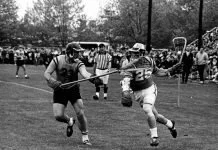Here at Cornell, we are lucky enough to learn amongst a diverse community of students and thinkers. It is this diversity that has encouraged the inclusion of all different types of people, regardless and in spite of our differences. But while we have come a long way in embracing others and making our campus accessible to all, we still have a long way to go—namely, in the way we respond to the needs of students with disability.
Seeking to address this issue and challenge stigma associated with disability, a group of students have teamed together to create an exhibit called “Ad[dress]ing Ableism.” Featuring designs by senior fiber science majors, Sam Stern and Molly Kestenbaum, the installation utilizes fashion to raise awareness about disability, acknowledging the broad spectrum across which disability is defined, and changing the way students across campus both think about disability and respond to it.

The exhibit, which opened on Monday, joined the efforts of five students from different majors across campus, each of whom being either involved with disability services or self-identifying as “disabled.” As senior and designer Molly Kestenbaum notes, “Having a disability does not mean one is disadvantaged, but rather advantaged in another way due to the development of a new skill set. Through this project, we discovered that fashion can be a powerful way to challenge the meaning of disability itself and empower individuals to feel the best in their respective bodies.”

When asked about why fashion was chosen as the medium for “Ad[dress]ing Ableism”, Kestenbaum noted how the current status of the fashion industry does not tailor to those with specific needs. “The industry for fashionable disability products is currently stagnant and lack-luster” she explained. Having “garments or products that are both aesthetically pleasing and simultaneously functional” can “help to positively represent the disability community” and normalize perceptions of disability in the mainstream public.

Of the creative process behind organizing the exhibit, SA President and contributor to the project, Jordan Berger, explained, “We met with eight models individually who identified with having a certain disability, including a hearing impairment, diabetes, eating disorders, scoliosis, ADHD, and cerebral palsy. During the meetings, we asked each volunteer what they wanted in their garments and tried to satisfy specific needs that were not being met.” The designs thus uniquely both reflect the obstacles facing those with disabilities and encompass how those obstacles can be overcome.
Ultimately, the event’s organizers hope that if the Cornell community takes away anything, it’s a better understanding of what disability is and help to make our campus more accommodating to their needs. “Often the needs of members of our community are not readily apparent to us even if the person has a visible disability,” Berger explains. “For instance, it is often evident to people that a necessary accommodation for a person in a wheelchair is a space that does not require stairs to enter. But we often forget about more intricate details such as access to an accessible bathroom.” By destigmatizing disability and promoting the inclusion of those with different needs, these students hope that this project will help to make Cornell a better place—not just for the disabled, but for everyone.
“Ad[dress]ing Ableism” will run in the Jill Stuart Gallery in the Human Ecology Building from Monday April 17th to Friday, April 22nd. For more information about the exhibit, click here.






